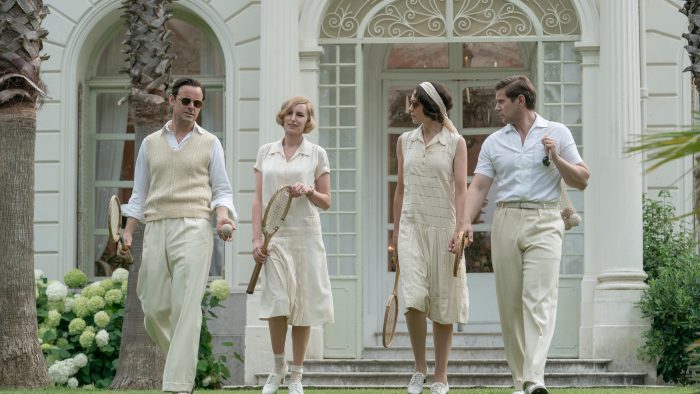Movie Review: ‘Downton Abbey — A New Era’ reminds us of a journey taken

Reviewed by Jeffrey Sanzel
In 2015, the landmark television series Downton Abbey ended its six-season run. Four years later, Downton Abbey arrived on the big screen (reviewed in this paper in September 2019). Set in 1927, the story focused on a visit from King George V and Queen Mary. While the film lacked the weight and depth of the series, it was a satisfactory outing for Crawley fans, featuring almost the entire roster of principals.
After several delays in release, Downton Abbey 2, rechristened Downton Abbey: A New Era, arrives. Picking up one year later, the film opens with the wedding of former chauffeur Tom Branson (Allen Leech) to Lucy (Tuppence Middleton), the illegitimate child of Lady Bagshaw (Imelda Staunton). The scene serves as a reverse curtain call of the entire cast—both upstairs and down.
A New Era weaves two unrelated plots. In one, the Dowager Countess (Maggie Smith) has inherited a villa in the south of France, left to her by a possible former paramour, the late Marquis de Montmirail. While the Dowager is too ill to travel, members of the household journey to meet the man’s irate widow (Nathalie Baye) and welcoming son (Jonathan Zaccaï). Here, questions arise regarding the Earl of Grantham’s (Hugh Bonneville) birth.
Meanwhile, in need of a cash influx, the family leases Downton to a film company. Lady Mary takes charge of the endeavor, dealing with the director (Hugh Dancy), who, in traditional Downton fashion, falls in love with her. The undertaking is made more difficult by its beautiful but crass leading lady (Laura Haddock), coupled with the reality that silent films are dying.
The plots serve to put the characters in action but do little more. However, they offer a reminder that the Downton universe revolves around property—acquisition, ownership, and maintenance. Beginning with Episode One, Downton Abbey was driven by the issue of entailment and succession. With this shadow no longer present, the tension is gone. Even the roof repairs seem less dire and more a whacky (and almost desperate) way to introduce a screwball element. There is something tamped down in the emergency.
The simplistic arcs are predictable and provide opportunities for glorious scenery and occasionally sitcom exchanges. There are many jokes at the expense of the film industry and the French, but the barbs are benign. The film is liberally sprinkled with minor subplots involving a peppering of romance and domestic frustrations, but these function to give the less active characters a bit of screen time.
Ultimately, the problem at the core of both films is that the characters have matured. They no longer have the life-and-death conflicts that shook their worlds and forced them to look outward and inward. The entire clan has become not just better people but their best selves. The often dangerous and destructive relationship that fueled the conflict between Lady Mary and her sister, Lady Edith (Laura Carmichael), no longer exists. If they are not best friends, they are as close as possible.
Even the usually destructive Barrow (Robert James-Collier) has become a more benevolent soul. Happiness is not bad, but it is not the furnace that heats a story. The roadblocks and hurdles are minor; the experience is almost tacit. The culmination of emotional growth is not necessarily the best dramatic force.
Because of this, the first two-thirds of the film are composed of brief scenes (sometimes as short as two or three lines), jumping from place to place and from one set of characters to another, allowing for barely a breath. The frantic, frenetic, and often whimsical quality has a Muppets Take Downton Abbey feel.
Strangely though, these are minor cavils. Watching A New Era—which is an improvement on the first—reminds us of the journey taken. The actors are uniformly true to the characters who have aged and seem appropriately worse for wear. The delicacy and honesty of the performances echo a world created over many years. The final act allows the characters to breathe. Even in the most contrived situations, the company is incapable of a wrong or false note.
In one of the most beautiful scenes, Isobel (Penelope Wilton) and the Dowager (Smith) reflect on their history, reminding us how these longtime adversaries developed a deep bond. This is the film—and Downton—at its best.
Many loose threads are tied up, providing closure. But the ending also honors the circle of life, composed of births and weddings, illnesses and deaths.
It would be a safe bet that there will be a Downton Abbey 3, probably dealing with the problematic situation in Lady Mary’s marriage to racing fanatic Henry Talbot (absent from the film as actor Matthew Goode had production conflicts). In addition, societal changes, financial challenges, and global conflict will likely offer myriad opportunities. And while nothing will take us back to the height of Downton Abbey, we will gladly join the Crawleys as they move forward.
Rated PG, the film is now playing in local theaters.






